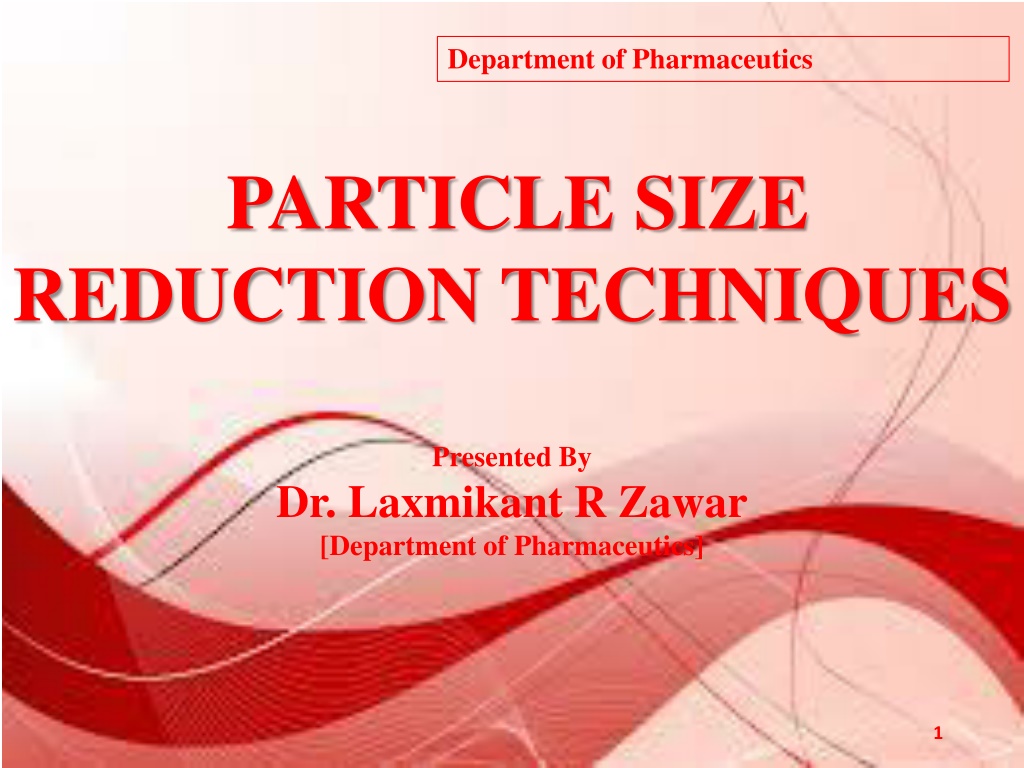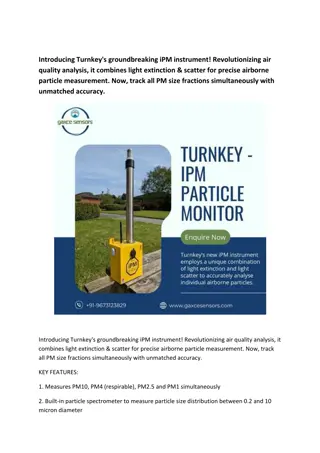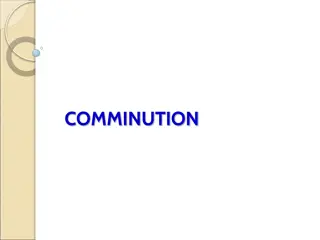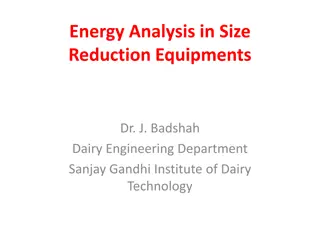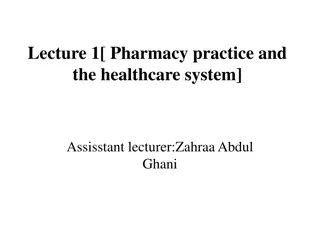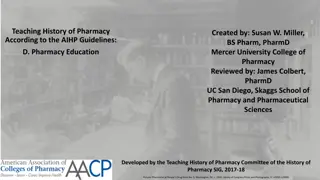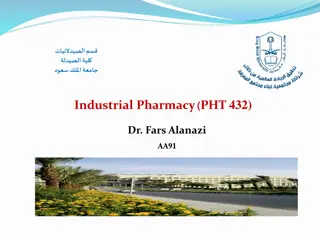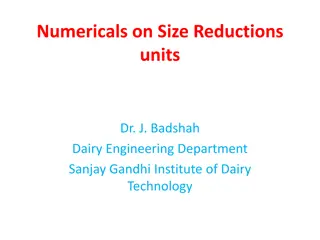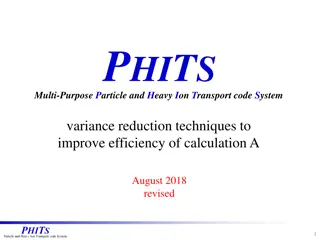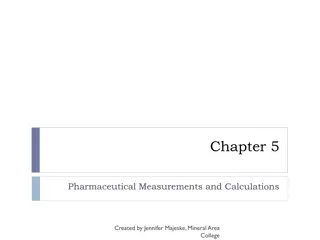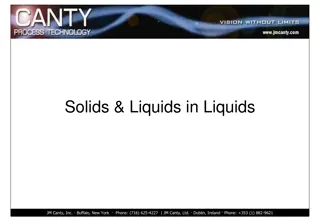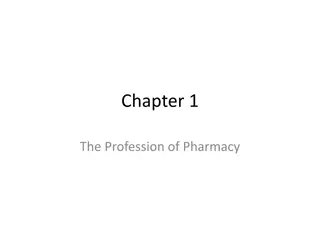Particle Size Reduction Techniques in Pharmacy: A Comprehensive Overview
Particle size reduction techniques in pharmaceutics are crucial for processing materials into desired sizes for various applications. This presentation by Dr. Laxmikant R. Zawar covers important methods such as rotary cutter mill, mortar and pestle, roller mill, and more. Each technique, including its principle, working mechanism, and applications, is discussed in detail, providing valuable insights into the field of pharmaceutics.
Download Presentation

Please find below an Image/Link to download the presentation.
The content on the website is provided AS IS for your information and personal use only. It may not be sold, licensed, or shared on other websites without obtaining consent from the author. Download presentation by click this link. If you encounter any issues during the download, it is possible that the publisher has removed the file from their server.
E N D
Presentation Transcript
Department of Pharmaceutics PARTICLE SIZE REDUCTION TECHNIQUES Presented By Dr. Laxmikant R Zawar [Department of Pharmaceutics] 1
CONTENTS INTRODUCTION CLASSIFICATION TECHNIQUES ROTARY CUTTER MILL MORTAR AND PESTLE FLUID ENERGY MILL COLLOID MILL EDGE RUNNER MILL END RUNNER MILL APPLICATIONS REFERENCES 2
TECHNIQUES ROTARY CUTTER MILL MORTAR AND PESTLE ROLLER MILL HAMMER MILL BALL MILL FLUID ENERGY MILL COLLOID MILL EDGE RUNNER MILL END RUNNER MILL 3
ROTARY CUTTER MILL Principle: In the cutter mill, size reduction involves successive cutting or shearing the feed materials with the help of sharp knives. Feed Milling chamber Stationary knives Rotating knives Fig: Rotary cutter mill 4
Working: Rotor disc rotate at 200-900 revolution per min. Feed material loaded through hopper. Material is cut between rotating & stationary knives in small pieces, therefore particle pass through the screen product is collected into receiver. Uses: Size reduction (finer than 80-100 mesh) of tough and fibrous material. Ex. Medicinal plant, plant parts and animal tissue. It also used in manufacture of rubber, plastics, recycling of paper waste and plastic material. 5
MORTAR AND PESTLE This is the classical and the simplest equipment for grinding. It is work on application of attrition and pressure. In this equipment both mortar and pestle are rotating. This equipment cannot be provided with a sieve for. continuous removal of fines. 6
ROLLER MILL Principle: The material is crushed (compressed) by the application of stress. The stress is applied by rotator wheels, rollers. Feed Hopper Rollers Fig: Roller mill. 7
Working: The rollers are allowed to rotate. The material is feed into hopper through gap between two rollers by applying high pressure material is cursed. Uses: Roller mill is used for crushing and cracking of seed before extraction of fixed oils and also used to crush soft tissue to help in the penetration of solvent during extraction process. 8
HAMMER MILL Principle: The hammer mill operates on the principle of impact between rapidly moving hammer mounted on a rotor and the powder material. 9 Fig: Hammer mill
Working: The hammers are allowed to be in continuous motion(8000- 15000 rpm) the feed material is placed into the hopper, whiles hammers are in continuous motion. Uses: Particle size obtained from 10-400mm. Also used to mill dry, wet and filter press cakes materials. Advantage: Easy to setup and clean up. Occupies small space. Disadvantage: Heat buildup during milling is more , therefore, product degradation is possible. Not suitable for milling of soft, tacky and fibrous materials. 10
BALL MILL Principle: The ball mill works on the impact between the rapidly moving ball and the powder material, both enclosed in a hollow cylinder. Thus, in the ball mill, impact or attrition or both are responsible for the size reduction. 11 Fig: Ball mill Fig: Ball mill
Working: fixed number of ball introduced and cylinder is close. The drug is filled into cylinder 60% of the volume. A Uses: can be obtained. Fine grinding with a particle size of 100-5 mm or less 12
Advantage: Very fine powder produce. Suitable for both wet and dry grinding processes. Close system, sterility can be achieved. Disadvantage: Very noisy machine. Not suitable for milling of soft, tacky and fibrous materials. 13
Fluid Energy Mill Principle: Fluid energy mill operates on the principle of impact and attrition the feed stock is suspended with in a high velocity air stream. 14 Fig: Fluid energy mill
Working: Powder is introduced through the inlet of venture. Air introduce through the grinding nozzles transport the powder in the circular track of the mill. The turbulent air stream break the particles colloids with each other and break. Particles are carried out to outlet and the coarse particle undergo recirculation. Uses: Fluid energy mill is used to reduce the particle size(10-325mesh) of most of the drugs such as antibiotics and vitamins. Ultrafine grinding can be achieved moderately hard material can be processed for size reduction. 15
Advantages: Contamination is not possible. Disadvantage: Not suitable for milling of soft, tacky and fibrous materials. 16
COLLOID MILL Principle: Colloid mill consist of 2 steel disc having very small clearance between them. One disc is rotating, while the other one is stationary. 17 Fig: Colloid Mill
Working: are mixed with the liquid vehicle before introduce into colloid mill Rotor is moved 3000 to 20000 rpm. The dispersion flow down and adher to the rotor. Suspension and emulsion are placed in hopper. The solid Uses: Colloidal dispersion, suspension, emulsion, and ointment. Advantage: Production of sterile product. Disadvantage: Not useful to dry milling. 18
EDGE RUNNER MILL Principle The size reduction is done by crushing due to heavy weight of stone. 19 Fig : Edge runner mill
Working: time travel around the shallow stone bed so the size reduction is achieved by sharing as well as crushing. Material to be ground is placed on the bed at the same Uses: Grinding tough material to fine powder. Advantages: Does not require attention during operation. Disadvantages: More space than other mill, Contamination, Time consuming, Not use for sticky materials. 20
END RUNNER MILL Principle: Size reduction is done by crushing due to heavy weight of steel pestle. Shearing stress is also involved during movement of mortar and pestle. Fig: End runner mill 21
Working: The material to be ground is placed in the mortar. The mortar revolves at a high speed. The revolving mortar causes the pestle to revolve during this process, size reduction is achieved. Uses: Use for fine grinding. Disadvantages: Not suitable for unbroken or slightly broken condition of drug. 22
APPLICATIONS Fine powder due to their higher surface area show rapid rate of dissolution and thus increase the rate of absorption in to the blood. Increase the chemical rate of reaction. Improves mixing and minimise segregation. Suspensions and emulsions have slow rate of settling and creaming. Topical preparation containing good spredability and less irritating. Absorption capacity is increase. Cosmetic products containing fine powder is less gritty. 23
REFERENCES Aulton , Aulton Pharmaceutics, The Design And Manufactures of Medicines, 1stEdition (1988), Churchill Livingstone; pp.140-144. Leon Lachman, The Theory And Practice Of Industrial Pharmacy, 1stEdition (1970), Varghese Publication House; pp. 34-45. Kamath A. Method Of Size Reduction And Factor Affecting Size Reduction In Pharmaceutics: A review.2013;4(8):57-64 Subrahmanyan C.V.S. Pharmaceutical Engineering Principles and Practices, 1stEdition (2001), Vallabh Prakashan; pp.148-164. Pawar Atmaram, Introduction to Pharmaceutics, 1stEdition (2008), Career Publication; pp. 207-214. 24
